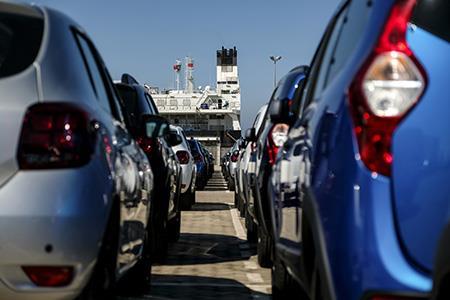The stubborn capacity crisis in the finished vehicle logistics sector in Europe will take time to mend, delegates at the Association of European Vehicle Logistics’ (ECG) Spring Congress heard last week, but industry dialogue is slowly helping to repair broken trust and disrupted contracting cycles.
Speaking as part of a panel at the event in Thessaloniki, northern Greece, Mats Eriksson of Axess Logistics Sweden, compared the current situation to a Rubik’s Cube, “in that every way you turn it you get a different pattern, but it is not immediately obvious how to solve it.”

Examining the challenges facing the industry today, the panel of representatives from OEMS and logistics services providers (LSPs) joining Eriksson discussed strategies to address persistent gaps in capacity across Europe and the hopeful path to recovery.
Acknowledging the complexity of the situation, Renault Group’s vehicle logistics expert, Hervé Moulin, pointed out that there is “no miracle action” that can be taken to alleviate the crisis but instead “lots of different solutions would need to work together”.
“We think the capacity crisis will continue even as volumes returns,” Moulin explained. “There are numerous factors that impact the sector now that were not so prevalent before the pandemic, for instance driver shortages or missing components.”
Jean-Christophe Deville, head of production and vehicle logistic at Toyota Motor Europe, concurred, noting that while Toyota has been helping LSPs to plan by improving its long-term forecasts, there was still a lot of room for improvement in the way data is distributed.
“We need to make sure we are sending information to the right people at the right time,” Deville said. “Often, we are sending our forecasts to the person we believe is the key decision maker but they are maybe not best placed to act on it or implement changes. We need to have more trust and more communication and get the Information to the right people.”
Contracts and inflation
The highly volatile outlook for the sector has had deep impacts, with volumes and contracts disappearing overnight in some cases and soaring inflation adding intense pressure to bottom lines across the industry. This led many LSPs to remove capacity to tackle costs but, as a result, has driven OEMs to the spot market.
“In some cases we have seen members being told a week or a day before a plant closure, which is not helpful for LSPs,” Bjørn Svenningsen, vice-president at ECG and director of sales and marketing at shipping line UECC, explained. “But we have to take some self-criticism as well, since OEMs are now choosing to charter trucks in the current market because we as LSPs didn’t provide them in the past and this in part is driving this trend.”
Svenningsen also said that inflation levels are going up across the sector and logistics providers had to ensure dialogue with OEMs was good to avoid uncertainty.

“We need to talk to each other. The acid test for long term partnership will come soon,” he said. “We don’t know when, but the market will turn and we will have oversupply again, and this will test strategic partnerships.”
Moulin noted that this dynamic meant that any solutions would not necessarily be easy but it is still vital for both sides to prove themselves trustworthy. “The first step is to restore confidence in new investment but this will not be an easy path as we have already been through a long string of crises and maybe these are not over yet.”
Improved planning is vital
Speaking on the role of forecasting in rebuilding European vehicle logistics networks, Ben Waller of consultancy ICDP outlined new work on behalf of ECG designed to lay the foundations for a better approach to forecasting.
“Planning processes broke down during Covid, and provision of useful forecasts have been slow to return at many OEMs. The challenge now is to address broken forecasting and contracting cycles at many OEMs,” Waller commented.
Based on a methodology that has been heavily revised in the wake of post-pandemic disruption, the joint ICDP and ECG research shows that the planning process is a central element in addressing the capacity crisis. With many OEMs now going to the spot market, LSPs have cut capacity and investment, leading to a spiral of higher costs and emissions, increased empty running and less consolidation.

“What can OEMs and LSPs do to start the journey towards a more stable planning process and sustainable relationship? Well OEMs should implement finished vehicle logistics forecasting as a centre of process excellence, and LSPs should ensure their approaches to communication and process reflect lean principle,” Waller said.
Concluding the ECG event in Thessaloniki, president Wolfgang Göbel highlighted the success of industry conversations so far in this context and praised structural changes that were bringing fresh approaches to the sector. He also noted that last week the ECG elected its first female board member, as part of a wider move towards greater equality in the vehicle logistics sector.
“A key aim of the ECG is the development of a toolbox for the sector, introducing a wide variety of tools that can help the sector improve and create a basis for more stable contracts,” Göbel said. “Instruments, such as the Finished Vehicle Logistics Index we have created with PWC, or our work around emissions reporting, are really important and the idea is to build up a layer of tools that cannot be broken, so that collaboration and contracts between LSPs and OEMs are stronger than ever in the future.”

























![Global[1]](https://d3n5uof8vony13.cloudfront.net/Pictures/web/a/d/s/global1_726550.svgz)














No comments yet